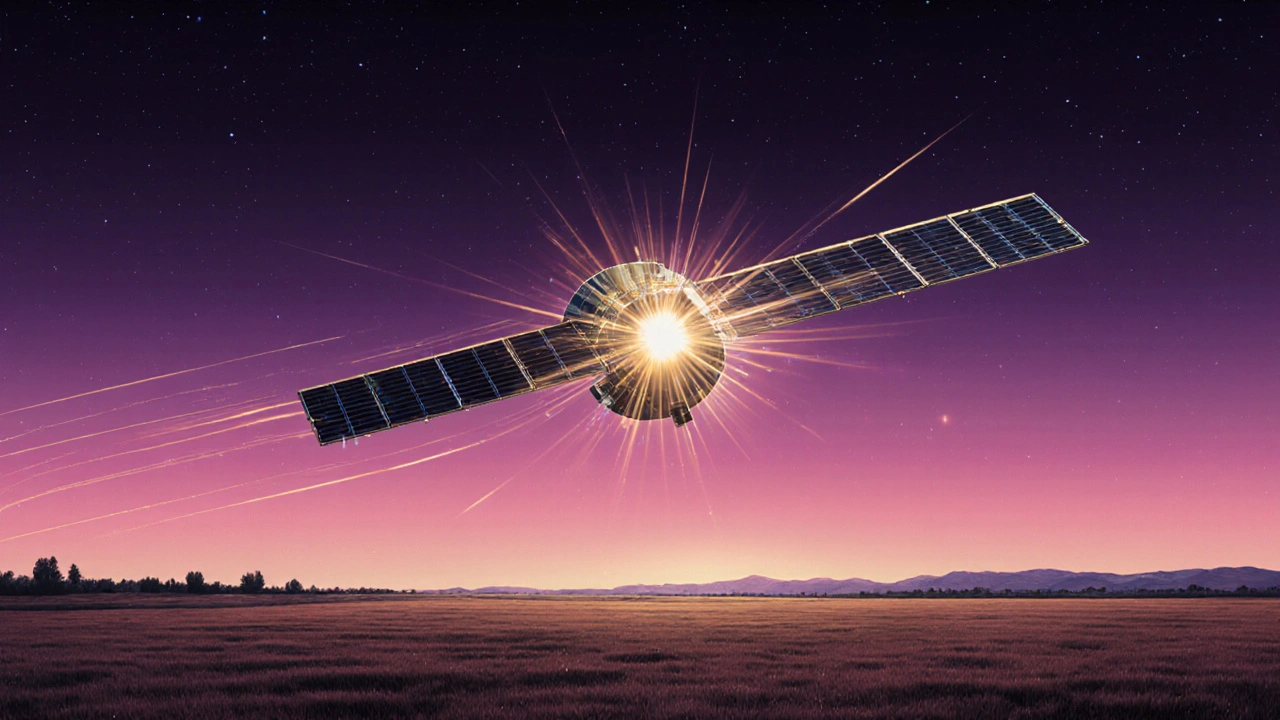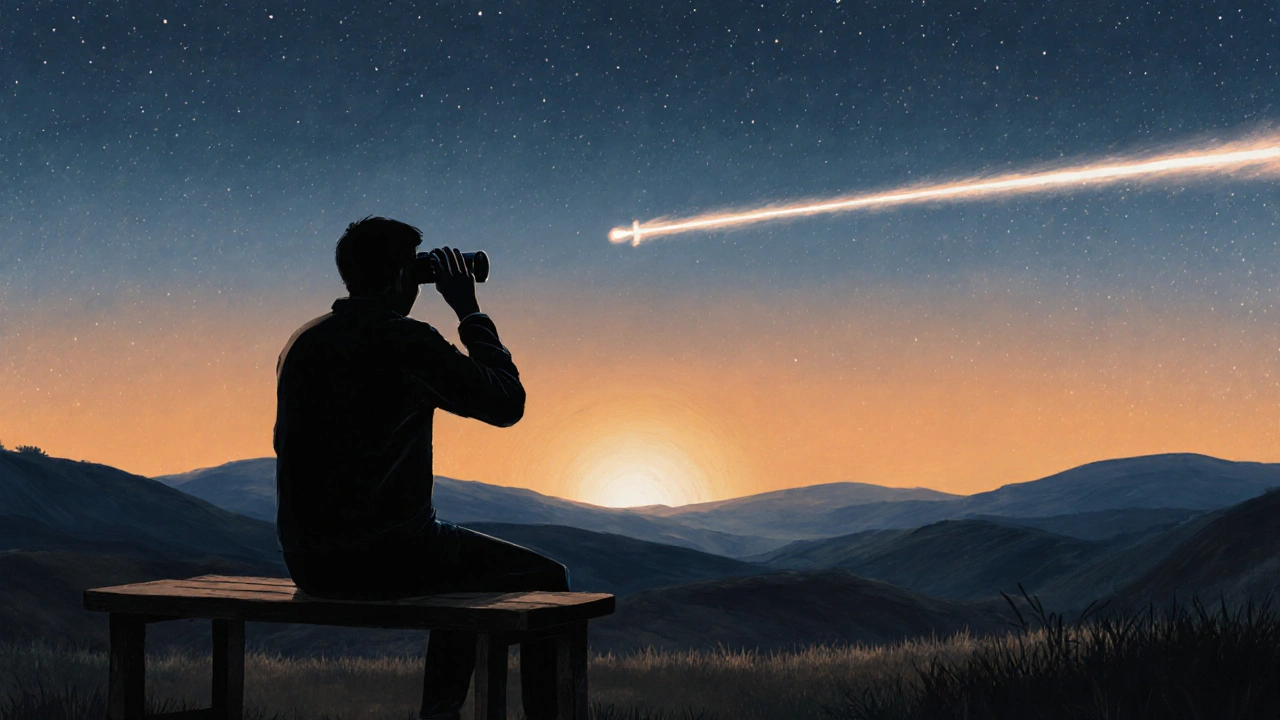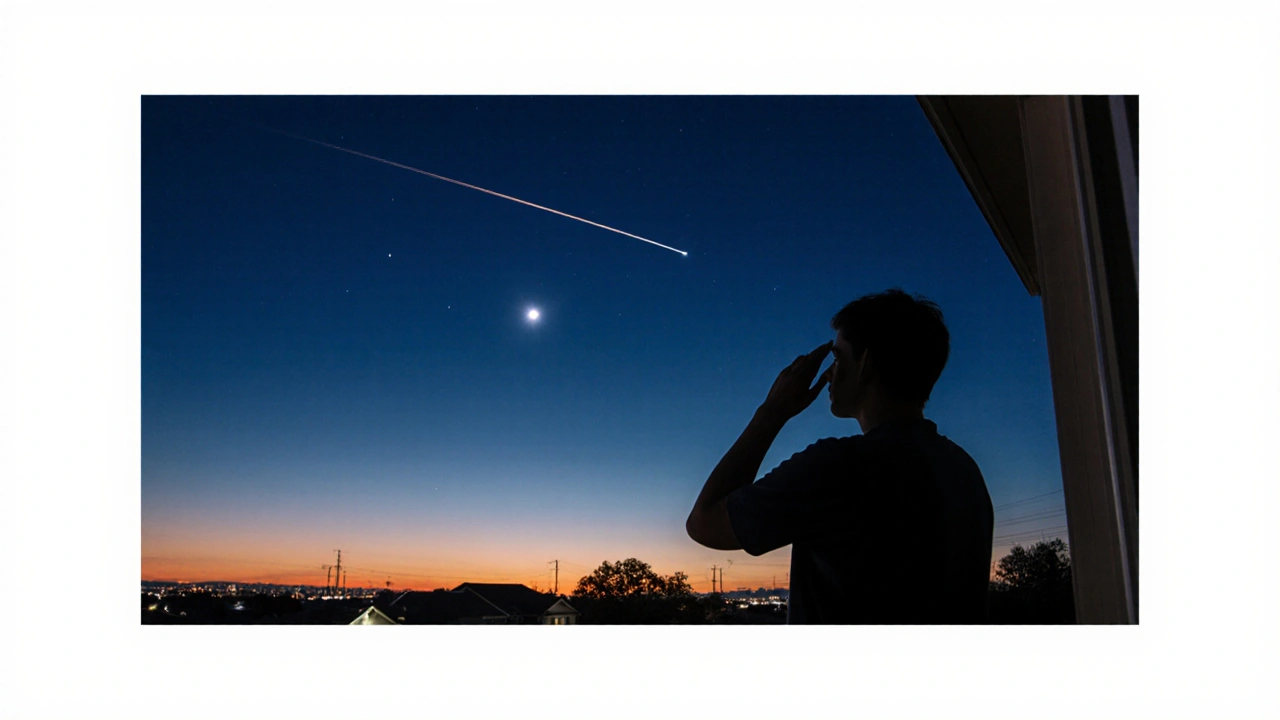Starlink Visibility Calculator
Estimate your monthly visibility based on your location and conditions
Your location is in the . You can see 2-4 passes per month under clear skies.
Ever glanced up on a clear night and wondered if that moving dot is a Starlink satellite or just an airplane? You’re not alone. The growing constellation of Starlink satellites has turned sky‑watching into a new hobby, but many people still ask: just how rare is it to actually see one?
Key Takeaways
- Starlink satellites are most visible just after sunset or before sunrise, when they catch sunlight while the ground is in darkness.
- In mid‑latitudes like Adelaide, you can expect to see a Starlink pass roughly 2‑4 times per month under good conditions.
- The brightness (magnitude) of a typical Starlink ranges from -2 to +4, making it comparable to bright planets.
- Higher solar activity and low cloud cover improve visibility; heavy light‑pollution zones reduce it.
- Spotting becomes easier if you track the satellite’s orbit using free apps or websites.
What Makes a Starlink Satellite Visible?
Visibility depends on three core factors: illumination, altitude, and observer’s sky conditions.
Starlink satellite is a low‑Earth‑orbit (LEO) communications satellite launched by SpaceX. Each unit orbits at about 550 km (340 miles) above the Earth, well below the International Space Station’s 400 km but above most weather satellites. Because they sit in LEO, they move quickly across the sky-usually 7,500 km/h-so the window of visibility lasts only a few seconds to a minute.
When the Sun is below the horizon but the satellite is still high enough to catch sunlight, the reflected light makes the satellite shine. This is called “twilight illumination.” If the Sun is too far below the horizon, the satellite slips into Earth’s shadow and disappears.
How Many Starlink Satellites Are There?
As of October 2025 SpaceX has deployed roughly 4,400 operational Starlink satellites, split across three major orbital shells. The first shell (around 550 km) holds the bulk of the constellation, the second (about 1,200 km) carries the “v‑band” upgrades, and a third (around 340 km) hosts the experimental “de‑orbit” test units.
With that many objects circling the globe, you might expect to see them all the time. In reality, only a handful of those in the low‑altitude shell are illuminated at any given twilight period, and most of them pass over the ocean or unpopulated regions.

Estimating How Rare a Sight‑ing Is
Let’s break the math down for a typical mid‑latitude location (e.g., Adelaide, 35°S). During the 30‑minute twilight window after sunset, roughly 20% of the low‑altitude Starlink fleet is sunlit. That gives us about 880 satellites that could potentially be visible.
From any single spot, the sky covers about 20,000 square kilometers. The satellites are spread evenly, so on average you’ll have about 0.04 visible satellites per square kilometer at any moment. Translating that to a human’s visual field (≈10,000 square degrees), you end up with roughly 2‑4 passes per month that are above the horizon, bright enough, and travel in a direction you can follow.
That number can spike during “satellite flares” - moments when the satellite’s solar panels reflect the Sun at the right angle, briefly reaching a magnitude of -2 (as bright as Jupiter). Such flares are rare, occurring perhaps once a year for any given location.
Best Times and Places to Spot One
- Twilight windows: Aim for the 30‑minute period just after sunset or before sunrise.
- Dark skies: Light‑polluted city centers wash out most of the faint passes. Head to suburbs, parks, or rural areas.
- Clear horizons: Look toward the western horizon after sunset and the eastern horizon before sunrise. Buildings and trees block low‑angle passes.
- Solar activity: Higher solar radiation expands Earth’s atmosphere, causing satellites to orbit slightly higher and stay illuminated longer.
- Tracking tools: Apps like Heavens‑Above, FindStarlink, or the SpaceX “Starlink Tracker” give precise pass times, azimuth, and magnitude.
How Starlink Compares to Other Satellites
| Satellite / Constellation | Typical Orbit (km) | Brightness (mag) | Average Passes per Month (mid‑latitudes) |
|---|---|---|---|
| Starlink (v0.9) | 550 | -2 to +4 | 2‑4 |
| Iridium NEXT | 780 | +5 to +7 | 1‑2 |
| OneWeb | 1,200 | +3 to +5 | 1‑3 |
| ISS (International Space Station) | 400 | -4 to -2 | ≈5 |
From the table you can see that Starlink satellites are generally brighter than Iridium or OneWeb, but not as bright as the ISS. That brightness makes them easier to spot, but the sheer number of passes still keeps them relatively rare for any single observer.

Practical Tips for Spotting
- Set a reminder for the next twilight window and open your sky‑watching app at least 10 minutes before the predicted pass.
- Use binoculars if you want to track the satellite’s trail; a 7×35 pair is compact and sufficient.
- Keep a notebook or a phone note of the time, direction, and magnitude. Over weeks you’ll notice patterns.
- Share your sightings on social platforms with the hashtag #StarlinkSpotting - you’ll often get feedback on nearby passes.
- Be aware of satellite de‑orbit phases. Older Starlink units are being lowered to 340 km for faster decay, making them appear brighter but lasting a shorter time.
Common Misconceptions
SpaceX is the private aerospace company that manufactures and launches the Starlink constellation. Many think all bright moving dots are Starlink, but most satellite flashes belong to other constellations or even the ISS. The key difference is speed - Starlink zip across the sky in 5‑7 seconds, while the ISS lingers for 4‑6 minutes.
Another myth is that Starlink satellites are “invisible” because they’re low. In fact, their flat panels are designed to reflect sunlight, which is why they’re visible precisely when they’re low enough to be illuminated but high enough to stay out of Earth’s shadow.
Mini FAQ
How often can I see a Starlink satellite from Adelaide?
How often can I see a Starlink satellite from Adelaide?
On average you’ll catch 2‑4 passes per month during the evening or morning twilight, provided the sky is clear and you’re away from heavy light‑pollution.
Are Starlink satellites brighter than the ISS?
No. The ISS can reach a magnitude of -4, making it brighter than most Starlink units, which top out around -2 during a flare.
Do I need special equipment to see a Starlink?
No. The naked eye can spot most passes. Binoculars help if you want a clearer view of the trail.
Why do some Starlink passes appear as a quick streak while others look like a flicker?
A streak occurs when the satellite stays in sunlight for the whole pass. A flicker happens when it briefly enters Earth’s shadow, causing the reflected light to dim and brighten.
Will the number of visible Starlink passes increase over time?
Not dramatically. SpaceX is already operating most of its planned low‑Earth‑orbit slots. Future launches will add more satellites, but the increase in visible passes per location is marginal because the sky can only accommodate a limited number of simultaneously illuminated satellites.
So, while a solitary Starlink sight‑ing feels special, it’s not an everyday event for most people. By timing your observations, heading to darker horizons, and using a simple tracking app, you can turn that rarity into a repeatable hobby.


7 Responses
Honestly, the whole Starlink hype feels like a fad for people who can’t appreciate real astronomy. You keep scrolling through endless apps as if the night sky is a Netflix show. The truth is most of us will only catch a few flashes a month, if you’re lucky enough to stand away from city lights. So stop pretending every streak is a life‑changing event.
yeah but the post makes it sound like you need a telescope to see them its not true you can see them with naked eye if the sky is clear and you look at the right time
Let me break it down with some sparkle. First, the twilight window is your golden ticket – that brief moment when the sun kisses the horizon but the satellites are still bathed in sunlight. Second, choose a spot with low light pollution; even a modest backyard away from street lamps does the trick. Third, keep your eyes peeled toward the western sky after sunset and the eastern sky before sunrise; that’s where the passes usually skim.
Now, tools matter. Apps like Heavens‑Above or FindStarlink will feed you exact pass times, azimuth, and magnitude, turning guesswork into precision. If you’re feeling adventurous, grab a pair of 7×35 binoculars – they’ll give you a crisp line of light without the bulk of a telescope.
Don’t forget to log your sightings. Jot down the time, direction, and how bright it seemed. Over weeks you’ll spot patterns, like certain days when solar activity boosts visibility. And when a satellite flares – that sudden brightening to magnitude – you’ll know it’s a rare gem, often only once a year for a given location.
Remember, the sky is a shared canvas. If you’re in a city, consider heading to a nearby park or rural fringe to escape the glow. Patience is key; wait out the clouds and watch the horizon patiently. With these habits, those 2‑4 monthly passes become familiar friends rather than elusive ghosts.
Hey folks, just wanted to add that cultural festivals often schedule night‑time events that line up perfectly with those twilight windows. If you’re already out for a concert or a night market, keep an eye on the sky – you might catch a streak without any extra planning.
Honestly, the whole thing is just a flash of vanity.
Nice point! 😊 Keep that binoculars ready, and you’ll turn those fleeting streaks into reliable sightings. 👍🌌
Let’s set the record straight: the post glosses over the fact that many of those satellites are being used for data collection beyond internet service. Some say the influx of reflectors is a deliberate ag‑gov plan to obscure other orbital objects. Also, note the grammar – “Starlink satellites are most visible just after sunset” should be “are most visible just after sunset, when they catch sunlight while the ground is dark.”